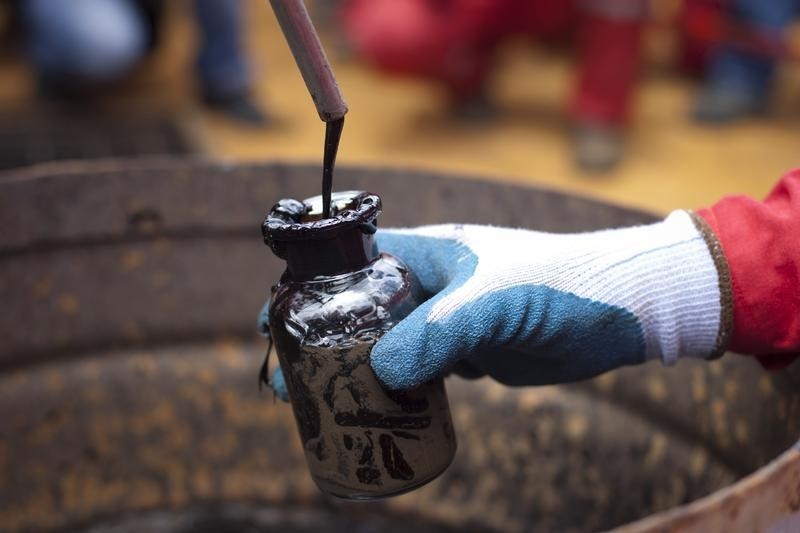Oil slumps 2% on weak U.S. manufacturing, new crude build forecast

LCO
+0.65%
Add to/Remove from Watchlist
Add to Watchlist
Add Position
Position added successfully to:
Please name your holdings portfolio
Type:
BUY
SELL
Date:
Amount:
Price
Point Value:
Leverage:
1:1
1:10
1:25
1:50
1:100
1:200
1:400
1:500
1:1000
Commission:
Create New Watchlist
Create
Create a new holdings portfolio
Add
Create
+ Add another position
Close
CL
+0.65%
Add to/Remove from Watchlist
Add to Watchlist
Add Position
Position added successfully to:
Please name your holdings portfolio
Type:
BUY
SELL
Date:
Amount:
Price
Point Value:
Leverage:
1:1
1:10
1:25
1:50
1:100
1:200
1:400
1:500
1:1000
Commission:
Create New Watchlist
Create
Create a new holdings portfolio
Add
Create
+ Add another position
Close
NYF
-0.13%
Add to/Remove from Watchlist
Add to Watchlist
Add Position
Position added successfully to:
Please name your holdings portfolio
Type:
BUY
SELL
Date:
Amount:
Price
Point Value:
Leverage:
1:1
1:10
1:25
1:50
1:100
1:200
1:400
1:500
1:1000
Commission:
Create New Watchlist
Create
Create a new holdings portfolio
Add
Create
+ Add another position
Close
By Barani Krishnan
Investing.com — Oil’s two-week rally paused meaningfully for the first time on Tuesday as crude prices fell as much as 2% from a contraction in U.S. manufacturing that reinforced fears of a recession in an economy still suffering relatively high inflation versus growth.
Expectations of a fifth straight weekly build in U.S. crude stockpiles also weighed on sentiment in a market that had risen in four of the past seven sessions.
New York-traded West Texas Intermediate, or WTI, crude for March settled down $1.49, or 1.8%, at $80.13 a barrel after an intraday low of $79.67. The U.S. crude benchmark rose nearly 15% over the past two weeks on bets of a huge pickup in demand from China, which this month abandoned COVID-related restrictions that had been weighing on energy usage in the world’s largest oil importer. Prior to the rally, WTI dropped 8.5% in the opening week of 2023.
London-traded Brent crude for March delivery settled down $2.06, or 2.34%, at $86.13 a barrel. The global crude benchmark rose 11% over the past two weeks, after an 8% slump in its debut week for the year.
U.S. business activity contracted in January for the seventh straight month, according to Standard & Poors’ first reading for 2023 although the downturn moderated across both the manufacturing and services sectors for the first time since September and business confidence strengthened as the new year began.
“Energy traders will wait to see how the supply side of the market evolves,” said Ed Moya, analyst at online trading platform OANDA. “Some energy traders are still skeptical on how quickly China’s crude demand will bounce back this quarter.”
Analysts at JPMorgan & Co raised their forecast for Chinese crude demand but maintained their Brent forecast for 2023 at an average of $90 versus higher expectations by market bulls. «Absent any major geopolitical events, it would be difficult for oil prices to breach $100 in 2023 as there should be more supply than demand this year,» JPM’s analysts said in a note.
Economies in the six-member Gulf Cooperation Council, or GCC, will grow this year at half the rate of 2022 as oil revenues take a hit from an expected mild global slowdown, Reuters said separately in a poll taken on the Arab world’s leading economies.
The Saud-led 13-member Organization of the Petroleum Exporting Countries and its 10 Russian-steered allies — collectively known as OPEC+ — is likely to keep output unchanged when the oil producing alliance meets next week, Reuters cited five OPEC+ sources as saying.
Market participants were also on the lookout for U.S. weekly oil inventory data, due after market settlement from API, or the American Petroleum Institute.
The API will release at approximately 16:30 ET (21:30 GMT) a snapshot of closing balances on U.S. crude, gasoline and distillates for the week ended Jan. 20. The numbers serve as a precursor to official inventory data on the same due from the U.S. Energy Information Administration on Wednesday.
For last week, analysts tracked by Investing.com expect the EIA to report a crude stockpile build of 0.971 million barrels in addition to the 8.408M rise during the previous week to Jan. 13. If correct, that would mean a total build of more than 30M barrels over the past five weeks, averaging over 6M barrels per week.
On the gasoline inventory front, the consensus is for an addition of 1.767M barrels after a build of 3.483M in the prior week. Gasoline inventories have gone up by almost 8M barrels to date since 2023 began. Automotive fuel gasoline is the No. 1 U.S. fuel product.
With distillate stockpiles, the expectation is for a drop of 1.121M after the previous week’s decline of 1.939M. Distillates, which are refined into heating oil, diesel for trucks, buses, trains and ships and fuel for jets, have been the strongest component of the U.S. petroleum complex in terms of demand. Distillate stockpiles have fallen by more than 4M barrels since the start of the year.

